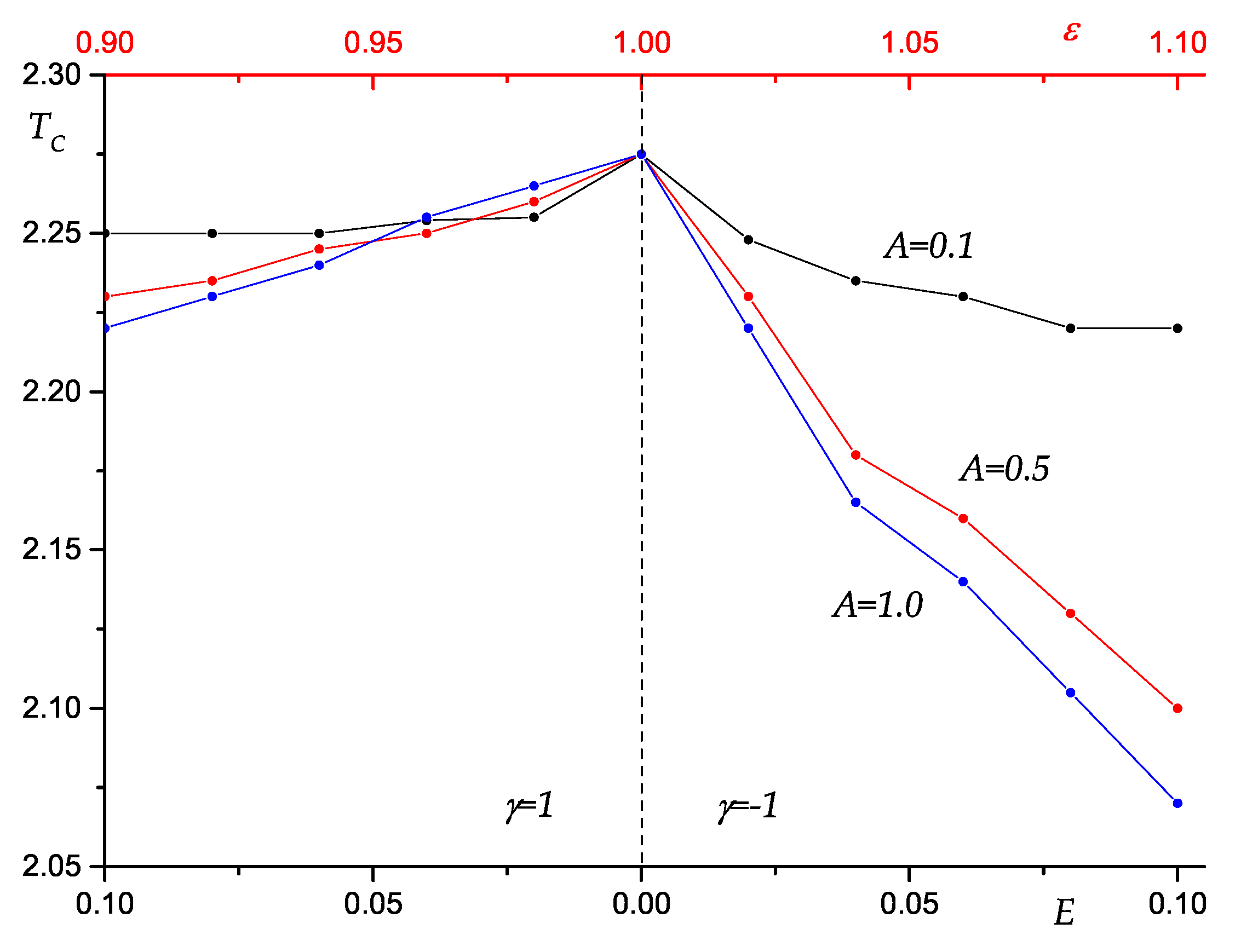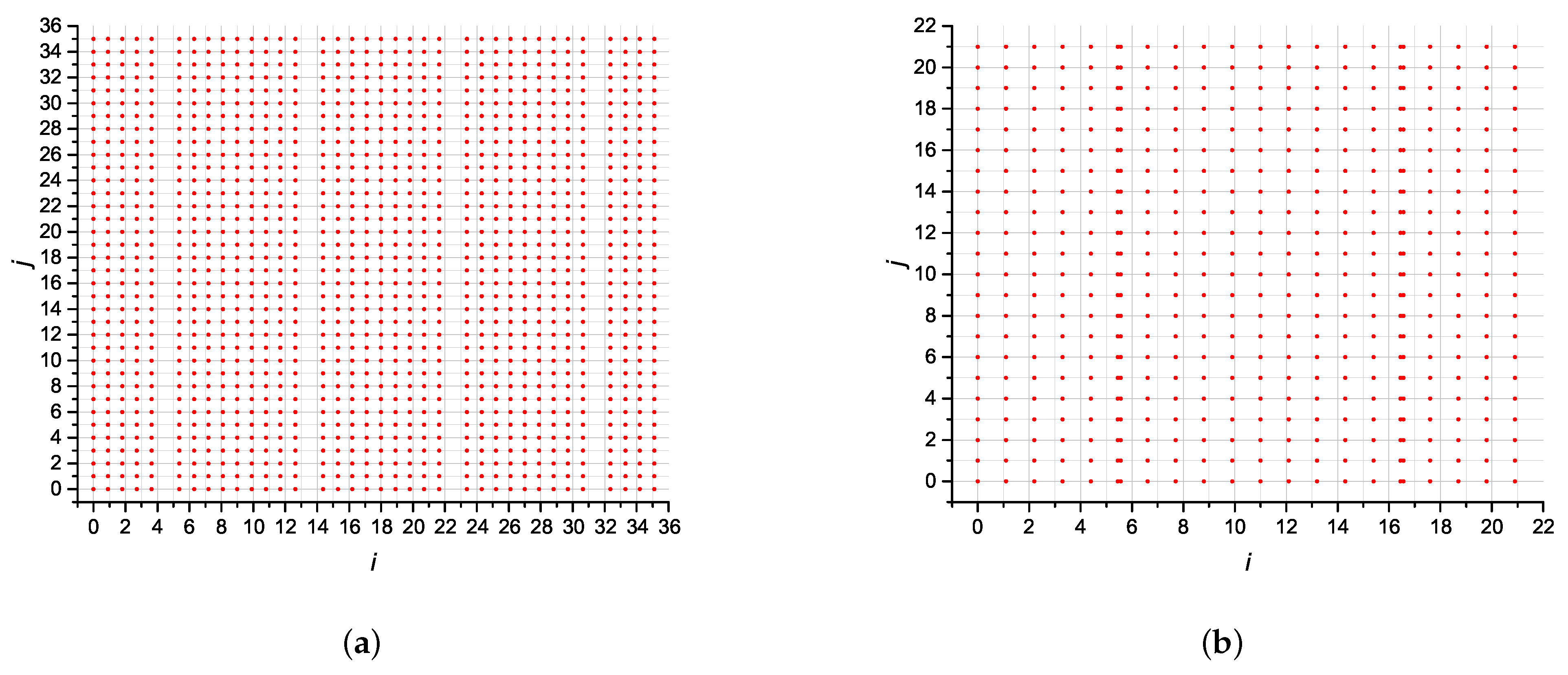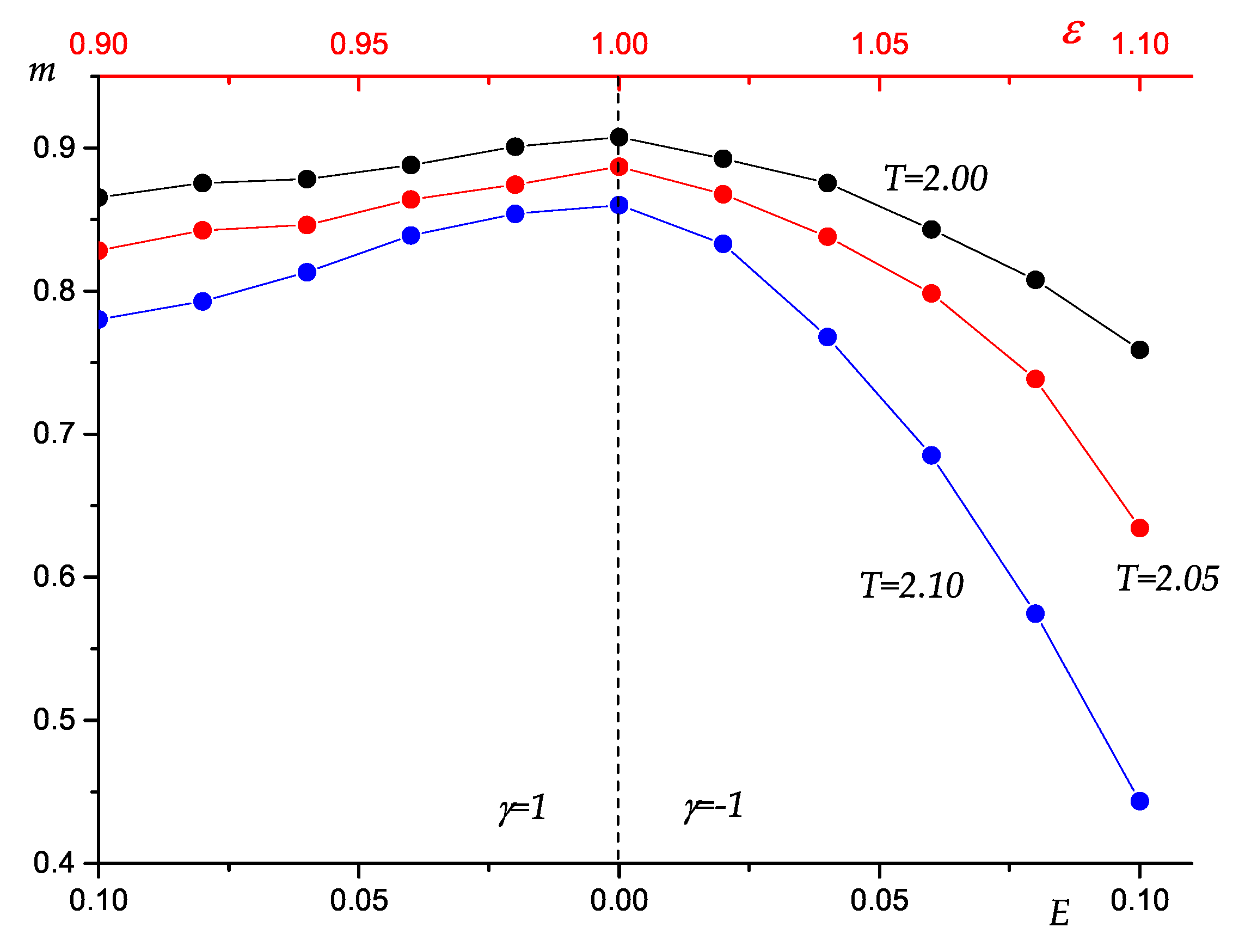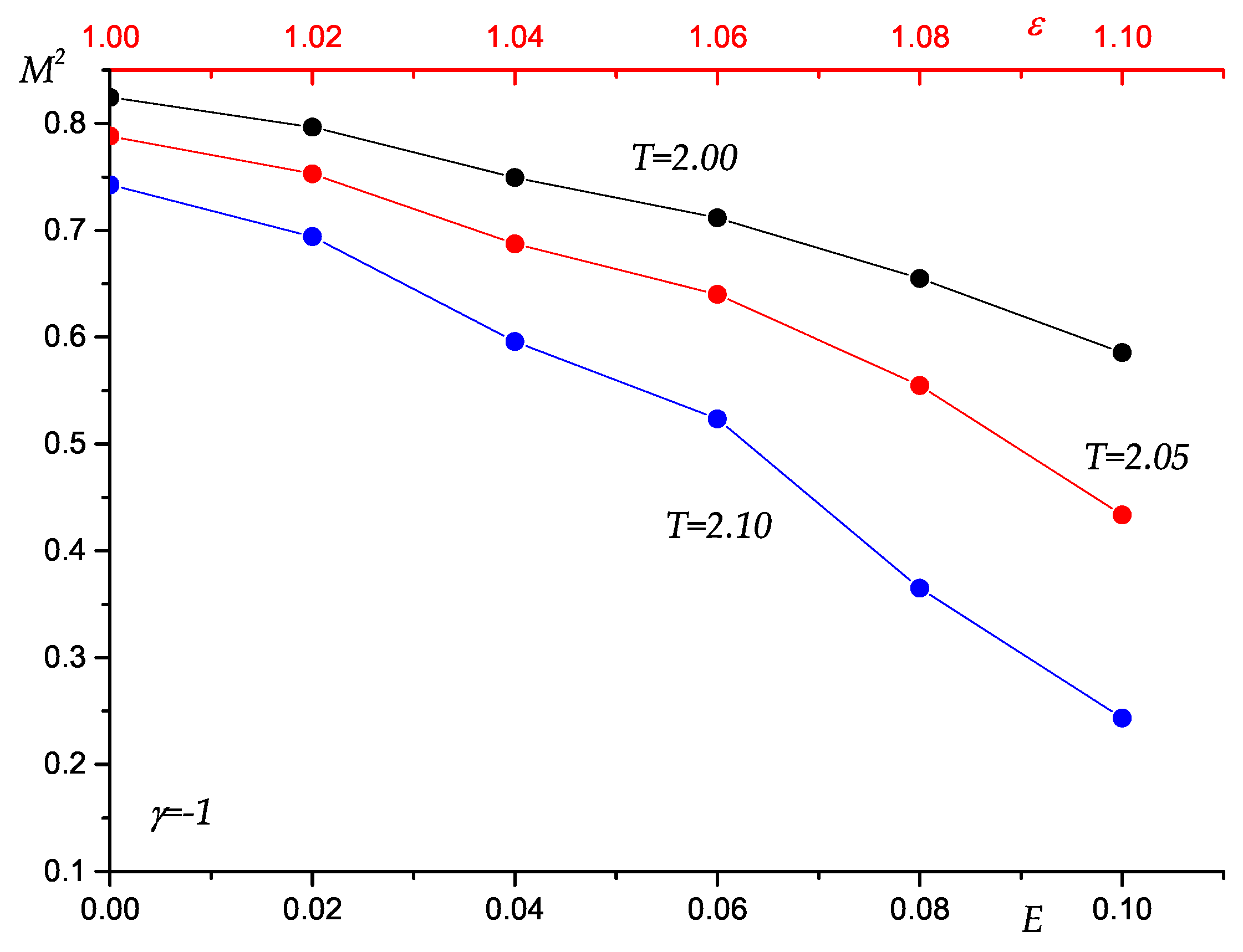1. Introduction
A wide range of spintronic devices uses the magnetoelectric (ME) effect in two-layer systems. The ME effect allows controlling magnetization with an external electric field. That, in turn, allows managing the conductivity of the system due to the phenomenon of giant magnetoresistance. A giant ME effect occurs in systems consisting of a thin FM film deposited on a FE substrate. One of the ME effect appearance mechanisms in such systems shows up due to the shift in the Curie point in the FM film under the substrate influence. The deformation of the FE substrate occurs in an external electric field. The film is also deformed due to the interaction of the atoms of the film and the substrate. Film deformation due to magnetostrictive phenomena leads to a shift in the Curie temperature. At a constant temperature, the electric field shifts the system position in the phase diagram relative to the phase transition point, which leads to a change in magnetization.
Experiments show that a change in the magnetization of thin films under the substrate influence occurs for various materials. Ultrathin platinum films on a BaTiO
FE substrate [
1] significantly change the value of their magnetic moment upon substrate deformation on an external electric field. The ME effect was observed in Ni films on the same substrate [
2]. The use of diffraction and reflection of X-rays in thin Pt/Co/Ta films on various FE substrates [
3] in an external electric field allows observing the change in the magnetic domains structure. A large magnitude of the ME effect was noted in thin FM films CoFe
O
/Pb(Zr
Ti
)O
/LaNiO
on a Pt/Ti/SiO
/Si substrate with the coexistence of FE and FM phases [
4]. A study of the change in the magnetic moment in a Ni
Co
film on a Pb(Mg, Nb)O
-PbTiO
substrate under the influence of an external electric field is represented in [
5]. This study revealed that the change in magnetization is a consequence of substrate deformations. A large ME effect of 560 mVcm
E
occurs in the Pb(Zr
Ti
)O
/LaNiO
/Ni [
6] heterostructure, where LaNi
serves as a buffer layer. Ba
Ca
TiO
/CoFe
O
thin films on Pt/Ti/SiO
/Si [
7] substrates exhibit a fairly large ME effect (82 mVcm
E
). FM films La
Ca
MnO
on a FE substrate BaTiO
demonstrate a Curie temperature decrease both under tension and under compression [
8].
Theoretical studies of the ME effect are focused mainly on specific substances. The microscopic model for Al
O
and MgO substrates [
9] became a basis for the investigation of the substrate impact on the magnetic properties of BaCoF
films. The phase transition temperature and the magnetization of the thin film increase for a compressible substrate, whereas they decrease for a tensile substrate. To study magnetization fluctuations in two-dimensional RMnO
films (R = Tb, Lu, and Y) on a FE substrate, the modified Landau model was used [
10].
Thus, in this paper, we study the FM phase transition and ME effect in two-dimensional films on a FE substrate from a common understanding of the crystal lattice symmetry and the interaction of atoms without reference to a specific substance.
2. Materials and Methods
We explore a two-dimensional FM film and investigate its magnetic properties within the Ising model. The undeformed film has a square lattice with a period of
a. The atoms located at the film sites are characterized by the value of the spin
S, which can take one of two values (+1/2 or −1/2). The Hamiltonian of such a system is as follows:
where
is the distance between atoms
i and
j.
is the exchange integral. Generally, the exchange interaction between spins decreases exponentially; thus, one can take into account the summation over the nearest neighbors only. When the film is deformed, the distance between the nearest neighbors changes. Therefore, it is necessary to consider the dependence of the exchange integral on the distance as follows:
where
is the exchange integral in an undeformed FM film. Parameter
determines the rate of the exchange integral decrease with distance and depends on the specific type of substance. This approximation leads to the fact that the effects of long-range action, which are present in some systems, are not taken into account. Long-range effects require considering the interaction not only with the nearest neighbors, but also with the second-nearest ones, and it can lead to a change in the critical temperature. For short-range systems, the exponential law is not universal as well; exchange interactions can be more complex, but this approximation is basic in spin models. Other forms of exchange integrals can be described using additive corrections to the exponential law; still, this is hard to be covered in a single article.
The influence of substrate manifests itself through the interaction between film atoms and substrate surface atoms. The substrate surface atoms affect geometric position of the film atoms, and this influence depends on their arrangement. In our simulations, we model the substrate as a two-dimensional potential with periodically located potential wells. We restrict ourselves to the case of a substrate with a square lattice. We use the two-dimensional FK potential to describe the film interaction with the surface of such a substrate [
11].
where
are coordinates of a point on the substrate surface,
and
are the periods of substrate potential along the OX and OY axis correspondingly, and
A is the amplitude of substrate potential. For an undeformed substrate, we assume the square crystal lattice and equal periods along both axes (
). External electric field leads to the deformation of the substrate crystal along the direction of the strength vector. We assume that deformation depends linearly on the electric field strength
E at low values of the tension. Within the computer simulation, we apply an external electric field along the OX axis. Thus, the lattice period changes along the OX axis.
where
is the relative deformation and
is the ferroelectric constant characteristic of the substance.
In addition to interaction with the substrate, mechanical interaction between atoms occurs in a thin film. As in the FK model, we restrict ourselves to the harmonic approximation. The energy of interaction between atoms has the following form:
where
g is an elastic constant, and (
) are the coordinates of the (
) atom.
It is necessary to minimize the total energy of the atomic system to determine the equilibrium position of the film atoms.
To search for the equilibrium state of atoms in the film, we use the Monte Carlo method. An unperturbed film with atoms at the sites of a square lattice with a period a is considered the initial state. The method of successive iterations determines the equilibrium state. One iteration consists of each lattice atom performing a test shift by a random vector, the length of which does not exceed 0.1a. If the new position reduces the total energy of the system, then it is taken. Otherwise, the atom returns to its previous position. In the equilibrium state, the iteration does not change the atomic arrangement.
The arrangement of film atoms on the substrate is determined by the competition between the interaction of film atoms with each other and with the substrate. For an undeformed system, atoms are located at the minima of the substrate potential. The minima are displaced relative to the initial position with a uniform substrate deformation. As a result, for some atoms, the interatomic interaction dominates over the interaction with the substrate, while for others, the substrate plays a more significant role. This leads to different displacements of atoms from the initial state, which manifests itself in the form of inhomogeneous deformations. Inhomogeneous magnetic film deformations with uniform FE substrate deformations along one axis were experimentally observed using X-ray diffraction in [
12].
Having determined the atomic positions in the film equilibrium state, we pass to its magnetic properties. We determine magnetization
m as the average spin per node.
where
N is the total number of atoms in the film.
We use the finite-size scaling theory [
13] to determine the temperature of phase transitions. System evolution proceeds according to the Wolf cluster algorithm [
14]. We investigate systems of different linear dimensions
L. For each of those, the dependence of the fourth-order Binder cumulants on temperature [
15] is determined:
Angle brackets denote averaging over thermodynamic states. We find the Curie temperature as the intersection of the graphs of the Binder cumulants versus temperature for systems with different linear dimensions.
3. Results
3.1. Computer Simulation
We review the systems with linear dimensions from L = 18 to 204 with the help of computer simulation. To satisfy the periodic boundary condition (if ), we must choose different sets of L for each b in such a way that the integer number of the L film atoms has an integer number of potential minima , i.e., , where L and integer. The central atom is fixed, and the boundary condition is periodical. The search for the equilibrium state of the film’s atoms took 100,000 Monte Carlo steps; the first 100,000 MC steps of the magnetic system evolution are discarded, and the magnetic properties are calculated in the next 50,000 MC steps.
For convenience, we pass to the relative values. We choose the film lattice period as a unit of length
a = 1. We consider systems with undeformed film in the initial state. This state is realized when the periods of the film and substrate coincide (
). In this case, the atoms of the film are located at the minima of the substrate potential. An external electric field operates along the OX axis; therefore, substrate deformations also occurred along the OX axis (
). The period of substrate potential along the OY axis is unchanged (
). We choose the unit value for the FE constant (
= 1). Different values of the FE constant will lead to changes in the electric field strength, while the main dependencies will not change. We perform calculations in the range of
E from 0 to 0.1. The compression or substrate stretching depends on the sign of
. Values
provide substrate compression and
,
lead to substrate stretching and
. For the elastic constant, a unit value (
g = 1) is also chosen. The units for the amplitude of the substrate potential are the same as that for the elastic constant. We perform the calculations for
A = 0.1, 0.5 and 1.0.
Figure 1 shows the dependence of Curie temperature on the external electric field strength.
It can be seen that substrate deformations under the external electric field lead to a Curie temperature decrease. These results on the Curie temperature behavior are in qualitative agreement with the experimental data [
8]. The authors observed a decrease in the phase transition temperature of the epitaxial film La
Ca
MnO
upon compression of the ferroelectric substrate BaTiO
by 1% from 240 K to 160 K. When the substrate was stretched by 6%, the Curie temperature decreased to 195 K. The decrease in the phase transition temperature is associated with rearrangement of the film crystal lattice. Deformations occur unevenly in both cases of compression and tension (
Figure 2).
As shown in
Figure 2, compression and tension along the OX axis lead to the formation of periodic strip structures in the FM film. In both cases, there is competition between two factors. Upon compression within each stripe, the atomic density increases, which leads to an increase in the Curie temperature. However, the formation of regions of reduced concentration between the stripes leads to a decrease in the phase transition temperature. Stretching inside each stripe decreases the concentration of atoms, leading to a Curie temperature decrease. However, layering of the neighboring stripes leads to an increase in the atoms concentration in the overlap region and an increase in the phase transition temperature. In both cases, the factors lowering the Curie temperature dominate, but the decrease in magnitude is different.
The ME effect consists of a change in the magnetization of the film when the system is in an external electric field. The ME effect is observed in a thin film in the FM phase. Therefore, we consider the system at temperatures below the Curie point.
Figure 3 shows the dependence of the thin film magnetization on the strength of the external electric field at three different temperatures.
The magnetization of an FM film decreases in an external electric field, due to the Curie temperature changes. An external electric field brings the system closer to the phase transition point at a fixed temperature, which leads to a decrease in magnetization.
3.2. Mean-Field Theory
Let us pass to the model of the system under consideration within the mean-field theory. The free energy of the system can be recorded as follows:
Here, is the free energy of magnetization of a thin FE film, is the deformation energy of a thin film, is the energy of magnetostriction, is the energy of deformation of a FE substrate, is the energy of the film–substrate interaction, and is the energy of interaction of a FE substrate with an external electric field.
Near the second-order phase transition, the magnetization energy term for an FM film can be written as a series in powers of magnetization [
16].
where
B is a positive constant.
where
is a positive constant,
T is the system temperature, and
is the intrinsic Curie temperature of the FM film in the absence of external influence.
The free energy with uniform film deformations are as follows:
where
x is the change in the linear dimensions of the film,
C is the modulus of elasticity of the film.
We can record the energy of elastic deformations of the substrate similarly as follows:
where
y is the change in the linear dimensions of the substrate, and
G is the elastic modulus of the substrate.
The energy of magnetostriction in most substances is quadratic:
where
D is the positive constant of magnetostriction.
The interaction energy of a FE substrate with an external electric field
E is linear:
where
H is a positive constant.
At small deformations of the substrate, we can take into account only the linear interaction between the deformations of the substrate and film.
where
R is a positive constant.
The free energy of a thin FM film on a FE substrate will have the following form:
The condition of the system equilibrium in an external electric field can be expressed as follows:
Hence, we obtain a system of equations for the equilibrium values of deformations (
) and magnetization.
Assuming the system is in the FM phase (
) and solving this system of equations, we obtain the magnetization dependence of a thin film on the electric field strength applied to the substrate.
The general view of magnetization dependence on the electric field strength has the following form:
Moreover, .
To compare this conclusion with the results of a computer simulation, we plot the dependence of
on
E at different temperatures (
Figure 4).
The behavior of curves is close to linear at low electric fields. At , the dependence ceases to be linear, and the mean-field theory is not applicable. An increase in temperature leads to a parallel displacement of the curves along the OY. The behavior of obtained curves is in qualitative agreement with the conclusions obtained with our model based on the mean-field theory.
To consider the change in the phase transition temperature in a thin film under the influence of substrate deformations in an external electric field, let us denote the new temperature of the phase transition
. The magnetization is zero as an order parameter of the system at the phase transition point. Thus, we can write down the following equation:
The temperature of the phase transition can be recorded as follows:
Thus, an external electric field leads to a Curie temperature decrease in a thin film on a FE substrate. Moreover, the temperature decrease depends linearly on the strength of the electric field. Comparing these results with
Figure 1, one can conclude that the mean-field theory is applicable only in weak fields.
4. Discussion
We modeled a computer simulation of the FE substrate influence on the condition and magnetic properties of 2D FM nanofilms. Our results show that the uniform deformations of the substrate lead to inhomogeneous deformations of the film. The interaction between the substrate and film atoms causes film deformations. When the substrate is compressed, it forms strip structures in the film. High-density stripes separate stripes with a low concentration of atoms. Substrate stretching leads to the formation of superstructures with an increased concentration of atoms. Heating or an external electric field can cause substrate deformations. In this case, a substrate-induced structural phase transition takes place.
A change in the film structure leads to changes in its magnetic properties. The Curie temperature is shifting, due to the substrate deformations. It decreases with both substrate compression and stretching. The phase transition temperature changing is caused by the dependence of the exchange integral on the distance between the spins. A decrease in the Curie temperature at any deformation of the substrate is explained by inhomogeneous changes in the atoms arrangement in the film. In both tension and compression, there is a competition of two factors. Areas of increased atomic concentration tend to increase the Curie temperature, while areas of decreased atomic concentration lower it. These trends are associated with the linear dependence of the phase transition temperature on the exchange integral. The regions with low atom concentration are dominant, due to the exponential decay of exchange integral with distance. Long-range effects can significantly change the dependence of Curie temperature on substrate deformations.
The trends in the magnetic characteristics behavior obtained in the simulation agree with the experimental data.










